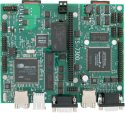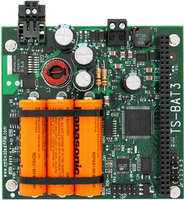Flexible ARM9 SBC boots Linux in 1.69 seconds
Aug 25, 2006 — by LinuxDevices Staff — from the LinuxDevices Archive — 2 views Technologic Systems is offering a freely downloadable, Debian-based Linux OS image said to boot from an SD card in less than two seconds, on the company's ARM9-based SBC (single-board computer). The TS-7300 SBC targets embedded applications requiring “extreme design security, flexibility, and reliability,” according to the company.
Technologic Systems is offering a freely downloadable, Debian-based Linux OS image said to boot from an SD card in less than two seconds, on the company's ARM9-based SBC (single-board computer). The TS-7300 SBC targets embedded applications requiring “extreme design security, flexibility, and reliability,” according to the company.
digg this story |
Technologic offers a freely downloadable, 66MB (compressed) Linux kernel and Debian filesystem image for the TS-7300 that is suitable for writing onto SD cards 256MB or larger. The image includes “software optimizations,” Technologic says, including “kernel tweaks, initrd tweaks, and a few tweaks inside the Debian filesystem itself.”
A hardware jumper on the TS-7300 can be toggled between normal Debian boot, or fast boot. When set to fast-boot, an initrd kernel is used, the Debian filesystem is mounted read-only, and a shell is executed, according to Technologic.
Technologic says the board can boot to a serial console prompt in 1.69 seconds. Getting to a VGA console takes a little longer — a leisurely 2.41 seconds — because of the need to initialize the FPGA, load a splashscreen, and activate the USB keyboard module, the company explains.
According to Technologic, hardware initialization takes 0.3 seconds, using an XIP (execute-in-place) bootloader stored in ROM. Bootstrapping Linux then consumes an additional 1.4 seconds. Thus, faster load times should be possible with smaller OSes, such as eCos, according to the company.
Cool, but what's the point?
 TS-BAT3 (Click to enlarge) |
Spokesperson Ronald Gomes says Technologic designed its fast-booting Linux implementation for cases where the TS-7300 board would be used in conjunction with its TS-BAT3 battery backup board.
Gomes explains, “The TS-BAT3 is a battery backup board that one can program to turn off the system and have it come back on (with or without external power) at an arbitrary time. Several applications of this are remote sensors where the SBC only has to be online every five minutes or so — just long enough to check a sensor or two, and go back to sleep. Checking a sensor may take only .01 seconds of CPU time most of the time. Your bootup time quickly becomes where the bulk of your battery/saved solar power is spent. Even at 1.69 seconds, 99 percent of your power was spent by Linux and firmware bootup boilerplate, and not your code.”
User-programmable
Another feature of Technologic's freely downloadable Linux 2.4 image for the TS-7300 is a Linux commandline utility said to be capable of reprogramming the board's onboard Altera 2C8 Cyclone II FPGA in 0.2 seconds, without requiring JTAG or ISP cables. The FPGA is fully user-programmable, although the board is supplied with a “default bitstream” providing hardware logic for the eight serial ports, second 10/100 ethernet port, second SD card slot, VGA video, and up to 35 DIO lines connected to the FPGA, which also has 8MB of SDRAM of its own.
The default bitstream appears to be based on a “boilerplate Verilog” design hosted at the OpenCores project.
Availability
More information about the fast-booting image, as well as a download link, can be found here.
The TS-7300 is available now, priced from around $220 and up, depending on RAM and other options. A $160 “developer kit” option adds a 512MB SD card with built-in USB interface, power supply, and cables.
More details and photos of TS-7300 SBC can be found in our earlier coverage.
This article was originally published on LinuxDevices.com and has been donated to the open source community by QuinStreet Inc. Please visit LinuxToday.com for up-to-date news and articles about Linux and open source.